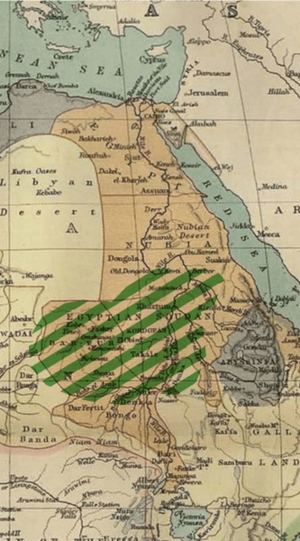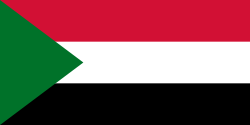Muhammad Ahmad facts for kids
Quick facts for kids Muhammad Ahmad |
|||||
|---|---|---|---|---|---|
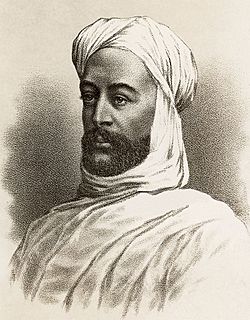
Artistic representation of Muhammad Ahmad
|
|||||
| Ruler of Sudan | |||||
| Reign | 1881–1885 | ||||
| Predecessor | Position established | ||||
| Successor | Abdallahi ibn Muhammad 'Khalifa' | ||||
| Born | 12 August 1844 Labab Island, Turkish Sudan, Egypt Eyalet |
||||
| Died | 22 June 1885 (aged 40) Khartoum, Mahdist State |
||||
| Burial | Omdurman, Sudan | ||||
|
|||||
Muhammad Ahmad (Arabic: محمد أحمد ابن عبد الله; August 12, 1844 – June 22, 1885) was an important religious leader in Sudan. He belonged to a group called the Samaniyya Sufi order. In 1881, he announced that he was the Mahdi. The Mahdi is a special leader in Islam, believed to be guided by God.
Muhammad Ahmad led a successful fight against the rulers of Sudan at that time. These rulers were from the Ottoman-Egyptian military. He even won a big victory against the British army during the siege of Khartoum. He created a large Islamic state that stretched from the Red Sea to Central Africa. His movement continued to be important in Sudan for many years.
His followers were called the Ansars. They helped set up the rules and beliefs of the Mahdist State. Muhammad Ahmad died unexpectedly in 1885. After his death, his main helper, Abdallahi ibn Muhammad, took over.
Abdallahi ruled as the Khalifa. But his strict rule and British military attacks eventually ended the Mahdist State in 1899. Even so, Muhammad Ahmad is still a respected person in Sudan's history. One of his direct family members, Sadiq al-Mahdi, later became prime minister of Sudan two times.
Contents
Early Life and Religious Journey
Muhammad Ahmad was born on August 12, 1844. His family lived on Aba Island, near the White Nile River. They were a simple family of boat-builders from a place called Dongola. His family believed they were related to the Islamic prophet Muhammad.
When Muhammad Ahmad was a child, his family moved to Karari. This town was north of Omdurman. His father, Abdullah, found plenty of wood there for his boat business. While his brothers learned boat-building, Muhammad Ahmad loved studying religion.
He studied with different religious teachers, called Sheikhs. He learned from Sheikh al-Amin al-Suwaylih and later from Sheikh Muhammad al-Dikayr 'Abdallah Khujali. Muhammad Ahmad wanted to live a very simple and spiritual life.
In 1861, he joined Sheikh Muhammad Sharif Nur al-Dai'm. This Sheikh was the grandson of the person who started the Samaniyya Sufi group in Sudan. Muhammad Ahmad stayed with Sheikh Muhammad Sharif for seven years. People saw how religious and devoted he was.
Near the end of this time, he became a Sheikh himself. He started traveling to teach religion to others. He was allowed to welcome new followers into the Samaniyya group.
In 1870, his family moved back to Aba Island. Muhammad Ahmad built a mosque there. He began teaching the Qur'an, which is the holy book of Islam. He quickly became known as a great speaker and a very spiritual person.
His teachings were about going back to the basic ideas of Islam. He taught about strict devotion, prayer, and living simply. These ideas came from the words of Muhammad and the Qur'an.
In 1872, Muhammad Ahmad invited Sheikh Sharif to move closer to him. At first, they were friends. But in 1878, they had a disagreement. Sheikh Sharif was not happy that his former student was becoming so popular.
Because of this, Sheikh Sharif removed Muhammad Ahmad from the Samaniyya group. Muhammad Ahmad tried many times to make peace, but his old teacher refused.
After this, Muhammad Ahmad went to another respected leader of the Samaniyya group. His name was Sheikh al-Qurashi wad al-Zayn. Muhammad Ahmad continued his religious life on Aba Island. He also traveled to Kordofan province. There, he met important people in the capital city, El-Obeid.
On July 25, 1878, Sheikh al-Qurashi died. His followers then chose Muhammad Ahmad as their new leader. Around this time, Muhammad Ahmad met Abdallahi bin Muhammad al-Ta'aishi. Abdallahi would later become his most important helper and take over after him.
Muhammad Ahmad Claims to be the Mahdi
On June 29, 1881, Muhammad Ahmad announced something very important. He said he was the Mahdi. In Islam, the Mahdi is a special leader who will appear before the second coming of Jesus.
His claim was partly based on him being a respected Sufi Sheikh. He had many followers in the Samaniyya group. The idea of the Mahdi was already important to the Samaniyya group. Sheikh al-Qurashi, the previous leader, had said that the Mahdi would come from their group.
Sheikh al-Qurashi also said the Mahdi would show certain signs. Some of these signs were from early Islamic times. Others were local predictions, like the Mahdi riding the Sheikh's pony.
Muhammad Ahmad said he was chosen as the Mahdi by a special meeting. This meeting was called a hadra. In the Sufi tradition, a hadra is a gathering of all prophets, from Adam to Muhammad. Many Sufi holy people are also believed to be there. Muhammad leads this meeting.
The hadra was also the source of other beliefs about the Mahdi. For example, it was believed that the Mahdi was created from a sacred light. This light was at the center of Muhammad's heart. It was also believed that all living things knew the Mahdi's claim since his birth.
Muhammad Ahmad said the Mahdiyya was a return to early Islam. He wanted the Muslim community, called the Ummah, to be united. This was like how it was under Muhammad and his first followers.
To make his followers different, he told them not to use the word darwish. This word was often used for Sufi followers. Instead, he called his followers Ansar. This was the same name Muhammad used for the people of Medina who welcomed him.
The Rebellion Grows Stronger
The Governor General in Khartoum, Muhammad Rauf Pasha, heard about Muhammad Ahmad's claim. He thought Muhammad Ahmad would be happy with a government payment. So, he sent a friendly letter. But the Mahdi sent a strong reply. He said, "He who does not believe in me will be purified by the sword."
Rauf Pasha sent a small group to arrest the Mahdi on Aba Island. But on August 11, 1881, the Mahdi's followers defeated them. This was the start of the uprising in southern Sudan. Rauf Pasha did not report the event as serious to Cairo. He sent the governor of Kordofan with 1,000 soldiers to stop the Mahdi.
When the soldiers arrived, the Mahdi had already left. He had gone southwest. The soldiers followed him, but they stopped when heavy rains flooded the roads. They went back to El-Obeid. The Mahdi then set up a new base in the Nuba Mountains.
The Mahdi and his followers, the Ansār (helpers), marched to Kurdufan. Many people joined them there. Important leaders like Sheikh Madibbo ibn Ali and Abdallahi ibn Muhammad became followers. The Hadendoa Beja also joined the Mahdi in 1883. They were led by Osman Digna.
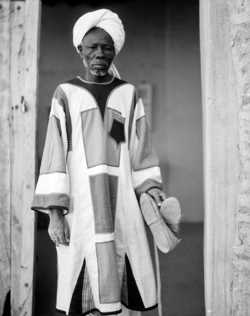
The Mahdist revolution had support from many parts of Sudan. It was supported by tribes from the north, west, and south. This showed that it was a national movement, not just a local one. The revolution also brought together different religious groups. Both non-Muslims and Muslims supported the Mahdi.
The Mahdi even changed some rules about slavery. He allowed free Muslims to be enslaved if they did not support him. But he forbade the enslavement of non-Muslims if they did support him. This was different from older Islamic rules.
In late 1883, the Ansār, who had only spears and swords, defeated an Egyptian force of 4,000 soldiers. They took the soldiers' rifles and ammunition. After this victory, the Mahdi surrounded El-Obeid. The city surrendered after four months because of hunger. El-Obeid then became the main base for the Ansar.
The Ansār grew to 40,000 fighters. They defeated another Egyptian army of 8,000 men. This army was led by a British officer named William Hicks. This battle happened at Sheikan, near El-Obeid. After Hicks's defeat, the region of Darfur also fell to the Ansār.
The success of the Ansār made the Hadendoa people bolder. Under Osman Digna, they destroyed a smaller Egyptian force. This force was led by Colonel Valentine Baker near the Red Sea port of Suakin. The British sent Major-General Gerald Graham with 4,000 soldiers. Graham defeated Digna at El Teb on February 29. But two weeks later, Graham's forces suffered many losses at Battle of Tamai. Graham eventually pulled his soldiers out.
The Siege of Khartoum
After much discussion, the British decided to leave Sudan in December 1883. They only wanted to keep a few northern towns and Red Sea ports. These included Khartoum, Kassala, Sannar, and Sawakin. General Charles George Gordon was given the job of evacuating Egyptian troops and other foreigners from Sudan. He was ordered to go to Khartoum and organize their departure.
Gordon Arrives in Khartoum
Gordon arrived in Khartoum in February 1884. At first, people were happy to see him. Many local tribes did not like the Mahdists. The routes north were still open, and telegraph lines were working. But soon after Gordon arrived, the Beja people started an uprising. This made communication much harder, and messages had to be sent by runners.
Gordon thought the routes north were too dangerous for the soldiers to leave. He asked for more soldiers from Cairo to help with the evacuation. He also suggested that his old enemy, Al-Zubayr Rahma Mansur, a good military leader, should be given control of Sudan. This was to help fight the Ansār. But London said no to both ideas. So, Gordon got ready for a fight.
In March 1884, Gordon tried to attack to clear the road north to Egypt. But some Egyptian officers joined the enemy. Their soldiers ran away after firing just one shot. This made Gordon realize he could only defend the city. He went back to Khartoum to build defenses.
By April 1884, Gordon had helped about 2,500 foreign people leave the city. His mobile force, led by Colonel Stewart, returned to Khartoum. This was after many times when the Egyptian soldiers under his command would run away easily.
Khartoum Under Siege
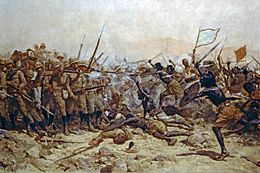
In April, the Ansār surrounded Khartoum. Gordon and his forces were completely cut off. But Gordon's defenses, especially his mines, scared the Ansār. They could not get into the city. When the Nile River rose, Stewart used gunboats to fight small battles. In August, he even recaptured Berber for a short time. But Stewart was killed soon after during another trip. Gordon learned this from a letter sent by the Mahdi himself.
The public put more and more pressure on the British government to help Gordon. Finally, Prime Minister Gladstone ordered Lord Garnet Joseph Wolseley to rescue Gordon. Wolseley was already in Egypt. He put together a large army, but they moved very slowly.
Knowing they would take a long time, Gordon asked Wolseley to send a "flying column" of camel troops. These troops crossed the Bayyudah Desert from Wadi Halfa. They were led by Brigadier-General Sir Herbert Stuart. This force was attacked twice by the Hadendoa Beja, also known as "Fuzzy Wuzzies". The first attack was at the Battle of Abu Klea. Two days later, they were attacked again near Metemma. Both times, the British soldiers held their ground. The Mahdists were pushed back with many losses.
At Metemma, about 160 kilometers (100 miles) north of Khartoum, Wolseley's first troops met four of Gordon's steamers. These boats were sent to quickly transport the first rescue soldiers. They gave Wolseley a message from Gordon saying the city was about to fall. Moments later, another message arrived, saying the city could hold out for a year. Wolseley decided to believe the second message. His force stopped to prepare the steamers for more troops.
Khartoum Falls
The rescue force finally reached Khartoum on January 28, 1885. But the city had fallen two days earlier during the Battle of Khartoum. After the Nile River's floodwaters went down, one of Gordon's officers, Faraz Pasha, opened the river gates. This allowed the Ansār to enter the city.
The soldiers defending the city were killed. Many men in the city were killed, and women and children were taken as slaves. Gordon was killed fighting the Mahdi's warriors at the palace. His head was brought to the Mahdi. The Mahdi ordered it to be placed in a tree for everyone to see. When Wolseley's force arrived in Khartoum, they tried to reach the city center by ship. But they were met with heavy gunfire and had to retreat.
The Mahdi's army continued to win battles. Kassala and Sannar fell soon after. By the end of 1885, the Ansār had moved into southern Sudan. In all of Sudan, only Suakin and Wadi Halfa remained in Anglo-Egyptian control.
Death and What Happened Next
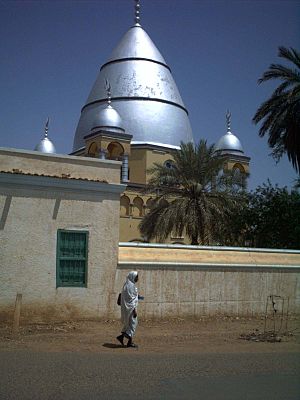
Six months after capturing Khartoum, Muhammad Ahmad died from a disease called typhus. He was buried in Omdurman, near the ruins of Khartoum. The Mahdi had planned for his death. He had chosen three helpers to take his place.
After the British defeated the Khalifa in 1898, General Kitchener ordered Muhammad Ahmad's tomb to be destroyed. This was to stop it from becoming a place where his supporters could gather. His bones were thrown into the Nile River. It is said that Kitchener kept his skull as a trophy. The skull was later buried at Wadi Halfa. The tomb was eventually rebuilt.
Muhammad Ahmad's Legacy
Political Impact
Muhammad Ahmad's son, Abd al-Rahman al-Mahdi, was born after his father died. The British saw him as an important leader of the Mahdists. He became a leader of the new Mahdist movement in the Anglo-Egyptian Sudan.
Some Sudanese people thought Abd al-Rahman should be the future King of Sudan when the country became independent. But he said no to the title for religious reasons. Abd al-Rahman supported the Umma (Nation) political party. This was before and just after Sudan became independent in 1956.
Today, Muhammad Ahmad is sometimes seen as an early leader of Sudanese nationalism. The Umma party says they are his political descendants. Their former leader, Imam Sadiq al-Mahdi, was Muhammad Ahmad's great-great-grandson. He was also the Imam of the Ansar, the religious group loyal to Muhammad Ahmad. Sadiq al-Mahdi was Sudan's Prime Minister two times.
Muhammad Ahmad is also an ancestor of the Sudanese-English actor Alexander Siddig.
See also
 In Spanish: Muhammad Ahmad para niños
In Spanish: Muhammad Ahmad para niños
- History of Mahdist Sudan
- In Desert and Wilderness (novel)
- Millennarianism in colonial societies
- List of Mahdi claimants
- Rabih az-Zubayr
- Reginald Wingate


